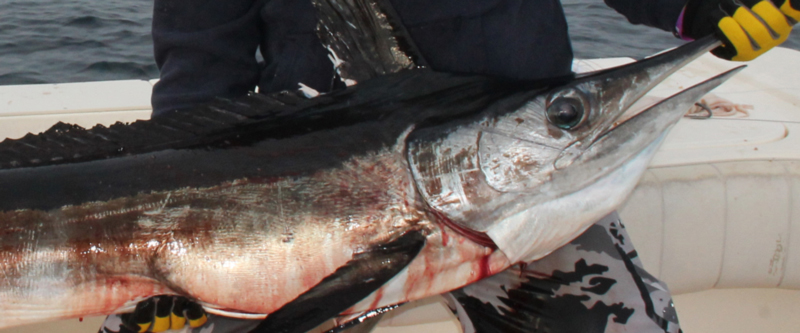What’s with all the dead fish pics!? In the recent past I’ve caught flack for allowing FishTalk to publish pictures of dead trophy-sized dead rockfish, of Spanish mackerel piled up like cordwood at the fish-cleaning station, and of a white marlin that was streaming more blood than a guest star on the season finale of Dexter. The worst of the fury came on Facebook (of course) but someone close asked me in person why I didn’t bury those sorts of photos, instead of publishing them. After attempting a brief explanation, I committed to spelling out my position in writing. Here goes:

I understand the pain that one can feel looking at an image of a big cow striper hanging from a scale. Yes, pain — I feel it, too. In truth, I feel a tiny bit of pain and regret every time I toss any fish into the box. It’s a reminder that we live in a cruel world; that in nature you have to pay to play. If you catch fish you will sometimes kill fish, certainly if you want to eat them and on occasion unintentionally, too. It’s a reality that we may not like, but we do have to face.
Activist anglers who want to protect stripers naturally get angry when they see a 40-plus-inch female, the future of the species, hoisted up for a glory shot after spending six hours in a fishbox. And concern over the harvest of fish like this is justified — which is exactly why it’s incumbent upon a media outlet like FishTalk to acknowledge that it goes on.
Let me pose a question to all the folks who think these pics should not see the light of day: Would burying them change the reality? Would you rather that no one knew fish like this were being harvested? Or, are we all better served if the broader fishing community has full knowledge, and if so inclined, initiates change?
I’d also point out that a picture rarely tells the entire story. Let’s say, for example, that a fish is gut-hooked and has little to no chance of survival. Is the right moral move to toss it over the side, or to put it on ice and eat it? Or in the case of the stack of dead macks, 30 fish certainly looks excessive in a photograph, but what if these fish were caught on a charter boat with 15 passengers aboard? Is two one-pound mackerel per client not a morally justifiable catch? We can argue about the answers, but the point is that there may be mitigating information that’s not understood with a glance at a photograph.
One more dilemma to ponder, comparing two anglers. Angler One is dedicated and effective, and catches 100 trophy-sized rockfish a year. They all get released immediately. Even in a best-case scenario, however, one or two of those fish won’t survive the encounter. Angler Two hasn’t honed their skills nearly as well, and catches just two or three trophy-sized fish a year. He or she decides to legally take home one of those fish per season to eat.
Who has the moral high-ground here? The intent of Angler One is clearly laudable, but this person may be responsible for inadvertently killing twice as many fish as Angler Two. Plus, those fish may be wasted, as opposed to feeding a family. My intent isn’t to judge which angler is in the right, but is only to point out that the correct judgement isn’t always clear cut.
There are plenty of Angler Ones out there who see Angler Two’s picture on Facebook, and start cancel-culture-style bashing. They may feel that they’re justified, and heck, in some cases maybe they are. But when you attack someone, they’re likely to dig in and become defensive. If instead you engage in polite discussion (such as “wow that’s a beauty, I wish there was a slot limit in all Bay waters so the big females always got released…”) you’re a lot more likely to encourage thought and introspection. And that’s probably a much better way to try changing the reality, as opposed to trying to pretend it doesn’t exist.